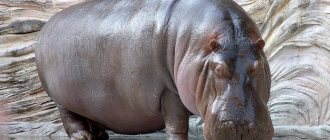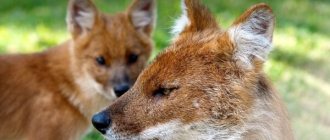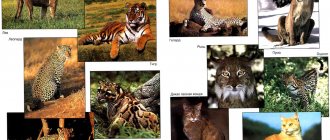Review author: “ZooVita”
Hippos lead a sociable, solitary lifestyle, with the exception of mothers with young animals. At night they graze alone, and during the day they form groups of an average of 10 to 15 animals. However, these gatherings are purely casual and there are no social connections between group members.
They usually live in a colony of 30 to 100 individuals. It consists of a single male and many females along with young animals, which can be seen in the photo of hippopotamuses. Males mark their territory by scattering droppings using propeller-like movements of their tails.
Description
The weight of adult individuals is 1300-3200 kg. Body length is 209-500 cm, including the tail - 35 cm. Height at the withers - 150-165 cm. Hippos have violet-gray or gray-green skin color, with brownish-pink areas around the eyes and ears. Their bodies are covered with a sparse amount of fine hair, with the exception of the head and tail. The outer layer of skin is extremely thin, making them vulnerable to injury during fighting.
Hippopotamuses lack sebaceous and sweat glands. Instead, the mucous glands secrete a thick, oily layer of red, pigmented fluid. For many years, this fluid was thought to be a mixture of sweat and blood. It is now known to be a mixture of hipposudoric and norhipposudoric acids. These compounds create a sunscreen effect by absorbing ultraviolet radiation from the sun and preventing the growth of pathogenic bacteria. Within a few minutes of exposure to sunlight on the animal's skin, the discharge changes from colorless to orange-red.
Bulky and barrel-shaped, hippos are seemingly clumsy on land and in water. However, their adaptation to life in a semi-aquatic environment allowed them to move quickly in water and on land. On the ground, they are capable of reaching speeds of up to 30 km/h and maintaining it for several hundred meters. In shallow water, their short legs provide powerful locomotion, and their webbed feet allow them to move along river bottoms with ease. The location of the eyes, ears, and nostrils high on the head allows hippos to remain under water most of the time, while breathing easily and controlling the environment around them. When fully submerged, the hippopotamus closes its nostrils and ears to prevent water from entering them. The jaws can open up to 150 degrees, revealing huge, sharp fangs and incisors. The canines grow up to 50 cm, and the incisors – up to 40 cm; the fangs are sharpened against each other while chewing grass.
Sexual dimorphism is present in hippopotamuses. Males usually weigh more than females (about 200 kg), but can grow to weigh several thousand kilograms. Males grow throughout their lives, while females stop growing at age 25. The maximum body length of males is about 505 cm, and females - about 345 cm. The largest male recorded in history weighed 4500 kg (Munich, Germany). In addition to their larger body size, males have much larger snouts with more developed jaws than females. The canines of males are twice as long as the canines of females.
Interesting Facts
Hippos in the water
Hippos (Hippopotamus amphibius) are large, water-loving animals native to Africa. Hippopotamus and hippopotamus are the same animal.
The word "hippopotamus" comes from the Greek word for "water horse" or "river horse", although they have nothing in common. According to the San Diego Zoo (USA), the closest relatives of hippopotamuses are pigs, whales and dolphins.
These are large and rounded animals, in size they are the third largest land mammal on the planet after elephants and white rhinoceroses.
You may like: What is better to feed a cat, dry or wet food?
They grow to sizes from 3.3 to 5 meters in length and up to 1.6 m in height. The female weighs on average about 1400 kg, the male from 1600 to 4500 kg. The average life expectancy is 36 years.
Hippo family
The notorious drug lord Pablo Escobar kept hippos, giraffes, elephants and other exotic animals at his estate in northwestern Colombia.
When Escobar was killed in 1993, the Colombian government confiscated all of his assets, including his personal zoo. Most of the animals were sent to zoos and aquariums, but four hippos were released into the wild in Colombia.
They found their way into local rivers and began to multiply there. Today, according to a study by biologists at the University of California, San Diego, 40 to 60 of their descendants roam Colombia. Unfortunately, this invasive population poses a threat to nature and the people of Colombia, destroying their crops and attacking them. Nevertheless, the Colombians fell in love with them and protect them from destruction, but scientists are afraid of the consequences that they can cause for the environment, because of this they caught some of the males and sterilized them, but for now they stopped there and are deciding their future fate.
When they bask in the sun, their skin secretes a red, oily substance on their skin. This gave rise to the myth that hippos sweat. In fact, this liquid is a natural analogue of sunscreen and a skin moisturizer for this animal.
Although these large mammals are constantly in the water, they cannot swim. While in the water, they walk along the bottom of the reservoir.
Habitat
Hippos usually inhabit shallow lakes, rivers and swamps. Their depth should be about 2 meters, since the hippopotamus immerses its entire body in the water. During the daytime, herds of hippopotamuses prefer to sleep in shallow water, and sometimes in shallow water (in mud), while closely grouping with each other. It is in such waters that mating and childbirth take place. When it is not possible to be in shallow water, hippos move into the depths and leave only their nostrils on the surface of the water to be able to breathe. At sunset, hippos come out of the water onto the shore to feed and travel around a bit. As a rule, they go no further than 1 mile along a familiar path of thick grassy grazing pastures along the water's banks.
Types of hippos
To date, scientists have identified several species of hippopotamus, both extinct and existing in the wild. These types include:
- The common hippopotamus or hippopotamus is a species that has survived to this day. Prefers to lead a semi-aquatic lifestyle.
- The European hippopotamus is an extinct species that lived in Europe during the Pleistocene period.
- The Cretan pygmy hippopotamus is also an extinct species that inhabited the island of Crete during the Pleistocene period.
- A giant hippopotamus that lived in Europe during the Pleistocene period. It is considered an extinct species that was hunted by Neanderthals.
- Pygmy Maltese hippopotamus , found during the Pleistocene period in Malta. The species is thought to have developed dwarfism due to a lack of natural predators.
- The Cypriot pygmy hippopotamus inhabited Cyprus until the beginning of the Holocene period. Although they are considered dwarf, their weight was at least 200 kilograms.
However, there are species that are conditionally assigned to this genus.
Reproduction
Hippos are polygamous animals, meaning that one male can mate with multiple females in the same social group. Although the reproduction of these mammals is not strictly seasonal, it usually occurs during the dry season, from February to August, and the birth of cubs occurs during the rainy season, from October to April.
When searching for a mate, the dominant male wanders around resting areas or pastures and sniffs the tail of each female. The male behaves unusually submissively towards the female in order to avoid attack by the herd. The goal of a respectful male is to find a female ready to mate. After the male finds the desired female, courtship begins. He teases his chosen one, thereby luring her out of the herd. He then chases her into deeper waters until she gets angry and collides her jaws with him. The male subjugates the female and the process of copulation occurs, while her head is under water. It is not clear why, but her head should be under water. If the female tries to raise her head to breathe in air, the male, as a rule, forces her to lower her head down. During mating, males make a hoarse signal sound, which indicates success. Although they can copulate year-round, the most common period is from February to August. Gestation lasts almost a year, 324 days, and one calf is born. It is not weaned from mother's milk for about a year, and maturity occurs at 3.5 years.
Before giving birth, pregnant females become very aggressive and defend themselves against anyone who comes across her. They isolate themselves on land or in shallow water and return to the herd 2 weeks after giving birth. At birth, the cubs weigh from 22 to 55 kg. Mother and calf have a close bond. They wash each other and hug each other, presumably showing affection for each other. Cubs are adapted to feed on mother's milk under water: the ears and nostrils close at the moment of sucking, when the mother's nipple is between the tongue and the upper jaw. Because hippos live in a social family, males are very protective of females and babies, and will often attack anything that poses a threat to them.
Natural enemies of hippos
Such large and strong animals do not have many enemies in nature, but lions and Nile crocodiles pose a particular danger. It should be noted that an adult male is capable of resisting an entire flock of large predators.
This is especially true for females who protect their young. Showing incredible aggression and strength, the female is able to protect her offspring even from several lions. As a rule, hippos become victims when they are on land, away from a body of water.
As a result of many years of observations, it has been established that hippopotamuses and Nile crocodiles generally do not conflict with each other and coexist peacefully within a particular body of water. Moreover, by joint efforts they can drive away potential enemies from the reservoir, and female hippos can leave their babies under the protection of crocodiles, who are able to protect them from hyenas and lions. Despite this, there are still cases when hippos show excessive aggression towards crocodiles, and they, in turn, can easily eat a newborn hippo, as well as a sick or wounded one.
Important fact! Despite the fact that hippos are still considered herbivorous mammals, they are also considered the most dangerous. They attack people much more often than predators such as lions and leopards.
Newly born hippos, as well as small and weak ones, are quite easy prey for the same crocodiles, lions, cheetahs, hyenas and hyena dogs, even if they are left without the supervision of their mother for a short time. Adult hippos themselves pose a considerable threat to young ones, since they can easily trample them.
Hippopotamus in action! Hippo against a lion, crocodile, elephant...
Behavior
Hippos are very social animals, living in groups of 20-100 individuals. They lead a sedentary lifestyle, resting most of the day, and at dusk they leave their pools and go to the pasture. Most activity occurs at night. Females are the leaders of the herd and control the calm in the pools during rest. Males rest along the outer banks of the water, thereby protecting females and cubs. At the age of 7, males begin to compete for dominance. This is expressed by yawning, roaring, splashing manure and clenching the jaws.
Dominant males are very intolerant of young males who challenge them. Adult males tend to severely injure and even kill young males during such fights. Territorial behavior is characterized by wheezing, honking, and dung showers. When approaching new territory, they turn the back of their body towards that location and mark the territory. They swing their tails from side to side and scatter their excrement around unfamiliar terrain. Males often emerge from the water to mark shorelines and grasslands where they feed.
The protection of their territories occurs during the dry period, when living conditions become more saturated and resources are limited. Defensive signs such as yawning, jaw clenching and fang ringing are designed to protect the herd from predators and to threaten other males.
Connection
As already written above, hippos are social animals and therefore have a wide range of above-water and underwater sounds. The signal call made by a hippopotamus underwater is the most common type of communication in a herd to communicate a threat. This hum can reach up to 115 decibels, which is equivalent to the sound of strong thunder. Vocalizations can be made on land and water, and accordingly, audibility is good in both places. This is the only case of underwater communication in mammals. The hippopotamus is able to make sounds when only its nostrils remain above the surface of the water. This happens because the hippopotamus has a thick layer of fat around the larynx, so at the moment of vocalization, the sound spreads throughout the entire volume of water.
Feeding at the zoo
Zoos mainly contain African and pygmy hippopotamuses; they are all herbivores and eat plant matter. The African hippopotamus regularly eats grass and other aquatic vegetation, while the pygmy hippopotamus eats regular grass.
They lead a quiet and sedentary life in the zoo, so they do not require high-calorie food. Zoo staff usually offer them a variety of food, adding various fruits to the grass.
In the video, zoo staff feed a hippopotamus with watermelon:
Nutrition
Hippos leave their waters at dusk and move to nearby grassy areas. They prefer to be close to water, however, if there is a lack of food, they can move several kilometers away. Grazing lasts for 4-5 hours every night. Their diet mainly consists of small shoots, grass and reeds. They do not dig up roots or fruit. However, hippos will consume many other types of plants if they are nearby.
The muscular lips, about 50 cm wide, are ideal for pulling grass. Hippos do not use their teeth to chew food; instead, they tear up grass to prevent loss. While their sedentary lifestyle allows for a simple diet, they are known to consume huge amounts of food each evening, 1-1.5% of their body weight (about 40 kg on average). Hippos enter and exit the water in the same place; they return from pastures before dawn. Sometimes, if a hippopotamus has gone too far from water, it will look for a body of water nearby so it can rest before the next nightfall. Some hippos have been spotted eating dead animals near their ponds. However, their stomachs are not designed to digest meat. It is possible that carnivorous behavior is a consequence of disease or malnutrition.
What do they eat?
Hippos are usually considered herbivores, but according to some reports, certain individuals are capable of hunting flesh and are carnivores. Thirst for blood appears due to too much deficiency of salts and minerals. As prey, giants attack cows and antelopes, and also eat carrion if the situation requires it.
The usual diet of hippopotamuses consists of thirty species of terrestrial and semi-aquatic plants, but they do not like to eat plants that grow at depth. Using their massive jaws, these mammals bite their food at the very root, tearing it clean out. They consume more than fifty kilograms of biomass per day. The long intestinal tract, which reaches 60 meters in size, helps process this amount of food. Thanks to this, the giant digests food twice as fast. They search for food at night, so local residents are afraid to approach water bodies late in the day.
The dwarf species is not able to hunt or consume huge plants, so it has to be content with fructose, vegetation and grass.
Role in the ecosystem
Thanks to their massive build, hippos occupy an important place in the ecosystem. Everyday existence in water and on land creates an ideal habitat for small organisms. When a hippopotamus goes to graze, it tramples down a path, which during the rainy season will serve as a lagoon or side pool and allow small fish to protect themselves during drought.
As with all mammals, several types of parasites live on the external and internal parts of the body. Monogenic worms live on the outer surface of hippopotamus eyes. They are attached to the inner edge of the membrane and under the eyelid. Although they do not cause serious damage to the eyes, they are an irritant to animals. Leeches and mites are usually found around the anal area of the hippopotamus. Other than blood loss and irritation at the attachment sites, there is no serious damage from these parasites. Flatworms are found in the stomach and the first 1.5 meters of the small intestine. The tapeworm creates cysts in the muscles during the larval phase. Flukes are most often found in the liver of young hippos, and it is believed that as hippos age, they become immune to the parasites.
Why is a hippopotamus dangerous for humans?
Despite the apparent clumsiness and feigned indifference to everything that happens, the hippopotamus is confidently one of the three most dangerous animals in Africa.
The animal's hot-tempered nature often leads to conflicts with people. Complicating the situation is the fact that hippos and people often settle next door, near the water. Hippos love to frolic in the fields of local farmers, causing the latter's justified indignation. In terms of the number of attacks on people (often fatal), the animal leaves far behind lions, rhinoceroses, elephants or buffaloes.
Security status
Over the past 10 years, the hippo population has decreased by 7-20%. It has been recorded that between 125,000 and 148,000 individuals remain in the 29 countries within its geographic range. Although poaching is illegal, it remains the leading cause of death for these animals. The hippos that inhabit unprotected lands suffer the most from poaching. Habitat loss is another factor in the decline of hippopotamus populations. Hippos depend on freshwater bodies, which makes them vulnerable to droughts, agricultural and industrial production, and rerouting of natural water flows. There are conservation measures for the hippopotamus population aimed at protecting natural habitats. Countries where there is a high population of hippopotamuses have strict regulations prohibiting hunting. The habitats of hippopotamuses, namely national parks, nature reserves, and museum reserves, are carefully protected.
Subspecies
The common hippopotamus is a member of the genus Hippopotamus. The pygmy hippopotamus, or Liberian pygmy hippopotamus, or pygmy hippopotamus belongs to a different genus - the pygmy hippopotamus.
Based on the morphological differences in skulls and the diversity of habitats, five subspecies of hippopotamuses are distinguished:
- a. Amphibius - ranged from Egypt, where it is now considered extinct, south to the Nile River in Tanzania and Mozambique;
- a. Kiboko is a subspecies found in Kenya, the African Great Lakes region and Somalia in the Horn of Africa. Representatives of this subspecies have wider nasal bones and hollower interorbital areas.
- a. Capensis - distributed from Zambia to South Africa. They have the most flattened skulls of all subspecies.
- a. Tschadensis - found throughout West Africa. The body is shorter and the muzzle is wider.
- a. Constrictus - can be found in Angola, southern Democratic Republic of Congo and Namibia. Has a deeper orbital constriction.
Where do they live?
At the moment, the main habitat of hippopotamuses is extremely limited, although just a couple of million years ago this animal could be found on almost every continent of the globe. Extinction is associated not only with colonizers and climate deterioration, but also with the onset of the Pleistocene ice age. Hippos cannot tolerate the heat of the sun, but their bodies cannot withstand the cold either. Moreover, for example, from some parts of western Africa the animal disappeared only in the ancient period, and from the territory of the Nile they disappeared only at the beginning or end of the nineteenth century.
Now these giants live south of the Sahara, in Africa. It can also be found near Mozambique and Malawi, in Uganda, Tanzania and Kenya. In these places, the number of individuals varies from eighty to hundreds of thousands. At present, destruction threatens not only the animals themselves, but also the places in which they live. This is due to rapid industrialization and the continued complete takeover of Africa. It is possible that hippos will soon become an endangered species.
The dwarf species lives in the same place as the ordinary one.











